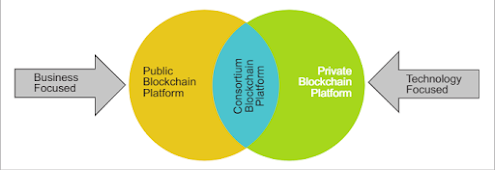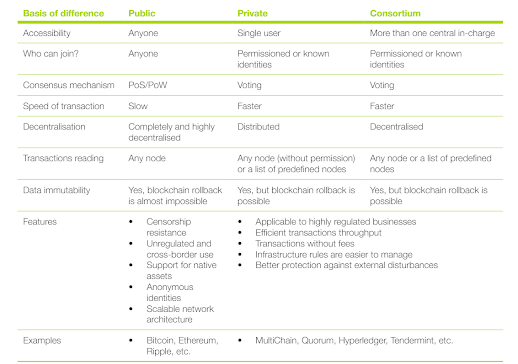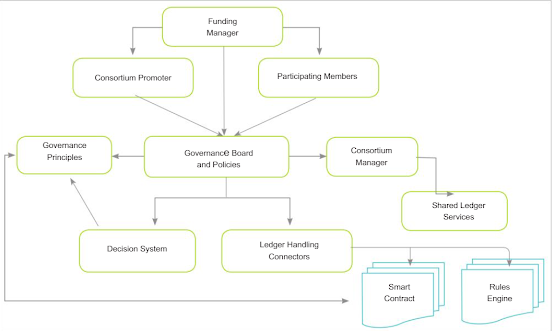The Blockchain Consortium is Coming of Age
Governance solutions for public blockchain platforms like Hyperledger and Ethereum were the prime focus of enterprises till recently. However, consortium blockchain governance is now slated to become as or even more important to enterprises than public blockchain governance and soon turn into a norm.
What is a blockchain consortium?
First, it is very important to understand that there is no universal blockchain governance. The type of governance depends on the type of blockchain solution that companies can use. There are three main types of blockchain systems: open or public, private or permissioned, and consortium or federated blockchains.
Most of us are aware of public and private blockchains but do not know much about a consortium blockchain. A blockchain consortium is defined as a type of network where multiple organizations maintain the system. Here, a group of companies collaborates on advancing the state of blockchain technology adoption in the industry, establishing industry standards, drafting use cases, developing key infrastructure, and also operating commercial blockchain platforms.
Consortium blockchains are termed as ‘hybrid solutions’; these fall in-between public and private solutions, i.e., between fully open decentralized systems, and completely centrally-controlled systems, thus getting the best of both worlds. Multiple organizations take part in the consortium and every organization gets similar treatment. So, there is no single entity ruling over the network. A survey by Deloitte in 2019 with regard to the impact of blockchain consortia on 1386 global enterprises, revealed the following statistics:
ƒ Cost savings: 57 percent
ƒ Accelerated learning: 55 percent
ƒ Risk sharing: 47 percent
ƒ Mass adoption: 45 percent
ƒ Lifetime maintenance: 42 percent
ƒ Influencing standards: 42 percent
How a blockchain consortium differs from public and private blockchain platforms
Blockchain is based on a peer-to-peer topology that allows data to be stored globally on millions of servers. It is also described as a P2P, decentralized, distributed ledger technology that works without involving any third-party intermediary or central authority, unlike traditional banks that rely on intermediaries.
Blockchain offers security, transparency, and immutability, and is attracting developers because of its potential to revolutionize the way industries and businesses work. As per a Deloitte survey in 2019, at least 76 percent of enterprises who are using blockchain solutions are moving towards a blockchain consortium or willing to move to it in the next 2-5 years due to its agility in architecture.
Blockchain platforms are classified as private, public, semi-private, and consortium. In fact, semi-private blockchain is the early version of a hybrid blockchain platform as it offers an enterprise-level public blockchain platform for businesses. As stated earlier, depending on their use and requirements, blockchains have been categorized into three types—public, private, and consortium (also known as federated). Each blockchain solves particular problems and has its own set of features and advantages.
Public blockchain
This blockchain is a permissionless, non-restrictive, distributed ledger system, which means anyone who is connected to the Internet can join and become a part of it. The basic use of such a blockchain is for exchanging cryptocurrencies and mining.
Moreover, it maintains trust among the whole community of users as everyone in the network feels incentivised to work towards the improvement of the public network. The first example of such a blockchain is Bitcoin, which enabled everyone to perform transactions. Litcoin and Ethereum are also examples of a public blockchain.
Private blockchain
Unlike the public blockchain, a private blockchain is a permissioned and restrictive blockchain that operates in a closed network. It is mostly used in an organization where only a few members are participants of the blockchain network. It is best suited for enterprises and businesses that want to use blockchain only for internal purposes.
The major difference between the private and public blockchains is that the latter is highly accessible, whereas the former is confined to a particular group of people. Moreover, a private blockchain is more centralized because a single authority maintains the network. Corda, Hyperledger Fabric, and Hyperledger Sawtooth are examples of private blockchains.
Consortium blockchain
A consortium blockchain (also called federated blockchain) is best suited for organizations where there is a need for both types of blockchains, i.e., public and private. In this type, there is more than one organization involved in providing access to pre-selected nodes for reading, writing, and auditing the blockchain. Since there is no single authority in control, it maintains its decentralized nature. Energy Web Foundation and IBM Food Trust are examples of such a blockchain.
Types of blockchain consortia
There are three types of blockchain
consortia:
ƒ Technology-focused
ƒ Business-focused
ƒ Dual-focused
Technology-focused:
A technology-focused blockchain consortium offers reusable blockchain platforms, and solutions based on technical standards. It has multi-purpose use cases. This type of consortium exists solely for the purpose of helping blockchain achieve global recognition. Examples are Quorum, R3 Corda and Hyperledger.
Business-focused:
This is intended to develop blockchain solutions for a specific business issue. Instead of offering open-source platforms, many prefer these consortia for commercial purposes only. Most of these are focused on industries like supply chain, health, trading, healthcare, etc. Examples are Bankchain, We. Trade, B3i, Marco Polo, etc. Dual-focused: The focus here is both on technology and business when offering a platform or solution. These offer open-source platforms suitable for the solution and commercial products as well. An example is R3.
Advantages of a blockchain consortium
ƒ Cost savings: The basic idea of being a member of a blockchain consortium is to cut expenses. It helps businesses cut costs.
ƒ Helps to accelerate learning: Blockchain consortia offer strong platforms for learning in terms of training and development support from experts.
ƒ Risk sharing: As blockchain is a relatively new technology, its adoption comes with a few risks. In a consortium, members collaborate with each other and thus reduce the risk factor, irrespective of whether the final solutions fail or succeed.
ƒ Mass adoption: Consortia help in the mass adoption of the technology.
ƒ Lifetime maintenance: A consortium offers a technology roadmap, helping businesses grow by leaps and bounds.
ƒ Influencing standards: Blockchain consortia are set to influence standards as blockchain will soon reach interoperability. The blockchain industry is expected to become a global trillion-dollar industry.
Governance model for blockchain consortium
Blockchain consortia have become popular in the past few years and are widely replacing legacy distributed workflow systems like simplified document management or semi-manual compliance systems.
Typically, in a blockchain consortium, we have various key entities, as shown in Figure 2 and explained below.
Founding member, who develops the governance model and the hierarchy of groups to be used in the blockchain platform.
Consortium promoter, who performs the administrative activity for implementing the blockchain platform of choice (R3, Hyperledger, B3i, Bankchain, etc), depending on the industrial solution and use case being addressed.
Participating members, who are the actual users of the blockchain platform; handle the transactions and prepare the interconnection between the nodes in the blockchain platform.
Governance principles define the principles to be used in the public and private blockchain solutions that are to be implemented in the architecture.
The Governance board and policies form the central authority to handle architecture decisions, based on the justification from the consortium promoter, participating member, and founding member.
Consortium manager decides on the rules engine and the smart contract to be used in the blockchain consortium to address the key transactional requirements.
Decision system helps to choose the responsibility to be handled by different governing bodies in the blockchain consortium units.
Ledger handling connectors help to connect to the shared ledger service or cross-platform services when using a combination of public and private blockchain platforms.
Rules engine defines the set of rules to be used for transaction handling and the business logic to be used for satisfying the blockchain execution workflow.
The smart contract is defined as the proof-of-work or proof-of-stake consensus algorithm and helps to handle the trustless entities in the blockchain platform.
The blockchain consortium governance model is designed in a way that helps to define a hybrid blockchain platform, which is semi-decentralized, to handle the workflow under the supervision of the consortium manager. It works as a permissioned ledger for a group of consortium promoters, based on the decision system. This makes the consortium behave like a multi-party consensus platform. Every transaction and operation is verified by a special group of pre-approved nodes, and every node is not allowed to do this kind of special approval.




